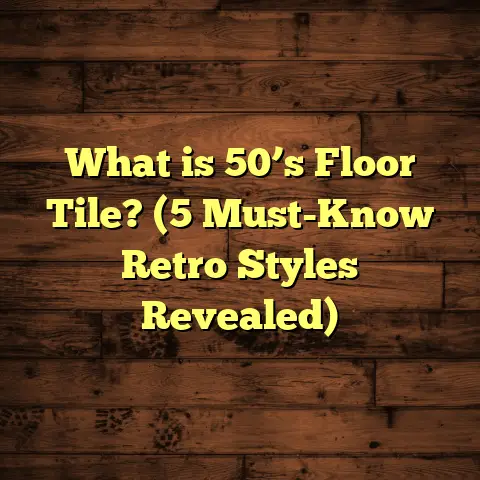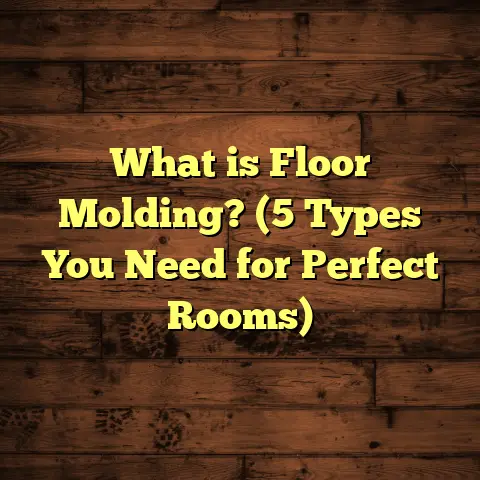What is Flashing a Floor? (5 Key Benefits for Homeowners)
Have you ever stepped into a room and felt something was just a bit off about the floor? Maybe it was a subtle warp, a little creak, or even some faint discoloration near the edges. It’s the kind of thing that nags at you but isn’t always easy to pinpoint. I’ve been there myself—many times, actually. And after years in the flooring world, one thing I’ve learned is that many of these issues could have been prevented with a simple, often overlooked step called flashing.
If you’re not familiar with this term, you’re not alone. Even many homeowners who invest in beautiful flooring aren’t aware of flashing and how crucial it can be for protecting their floors and home structure over time. So let’s take a closer look. What is flashing a floor? Why does it matter? And what benefits can it bring you as a homeowner?
What is Flashing a Floor?
Flashing a floor is essentially about waterproofing and protecting the edges and joints of your flooring system where moisture is most likely to sneak in. It involves installing a barrier—typically made from metal strips, rubber membranes, or specially designed tapes—that prevents water from penetrating beneath your floor covering.
You might recognize flashing from roofing or window installations where it keeps rain out, but its role under floors is equally important. Especially in areas like basements, kitchens, bathrooms, or entryways where moisture exposure is higher.
Where Does Flashing Go?
Flashing is usually installed:
- Along the perimeter where the floor meets walls or door frames.
- Around plumbing penetrations like pipes or drains.
- At transitions between different flooring types.
- At seams or joints in subfloor materials.
The goal? To stop moisture migration from seeping underneath and causing damage to wooden subfloors, adhesives, or underlayment materials.
Why Is This Important?
Because moisture is one of the biggest enemies of any flooring system. When water or humidity finds its way beneath your floor covering, it can cause warping, mold growth, wood rot, and even structural damage that compromises your entire home’s integrity.
I’ve seen plenty of floors ruined simply because this step was skipped or done poorly. And unfortunately, moisture damage often doesn’t show up immediately—it can take months or even years before problems become visible.
My Experience with Flashing Floors
Let me share a story from when I first truly appreciated the value of flashing floors. A homeowner called me over after noticing some strange buckling and discoloration in their newly installed hardwood basement floor.
At first glance, everything looked fine on top. But after pulling back part of the floor carefully, we discovered water had been creeping through small cracks in the concrete slab below. There was no flashing or waterproof membrane installed during the initial job.
The wood subfloor was soaked and starting to rot. It was an expensive fix that could have been avoided with proper flashing.
After that job, I made it a point to always educate my clients about flashing and moisture barriers. It’s not just about making floors look good but about protecting their investment and health long-term.
1. Protects Your Floors from Water Damage
Water damage causes more flooring problems than almost anything else.
I’m talking about:
- Warping
- Buckling
- Staining
- Delamination (in engineered wood and laminates)
- Cracking
In my years working as a flooring contractor, I’ve seen water damage start from so many sources: roof leaks dripping down through walls, plumbing leaks hidden behind cabinets, even condensation buildup in humid climates.
Why Moisture Is So Damaging
Most wood flooring products absorb moisture. When wood takes in water, it swells unevenly and then contracts when dry—this leads to warping and gaps. Even synthetic materials like laminate rely on adhesives that fail when wet.
Statistics from the National Wood Flooring Association estimate that moisture-related issues cause roughly 40% of all floor failures across residential installations.
Flashing acts as a shield against this risk by blocking water at vulnerable points before it reaches the subfloor or wooden planks. It keeps water on top rather than letting it infiltrate below.
Real Data on Flashing Effectiveness
A study published by a building science research group found that floors with proper flashing and waterproof membranes reduced moisture penetration by up to 85% compared to those without.
This kind of reduction not only prevents visible damage but also extends flooring lifespan by reducing long-term exposure to damp conditions.
2. Helps Avoid Mold and Mildew Growth
Have you ever smelled that damp, musty odor in basements or bathrooms? That’s mold and mildew growing quietly beneath surfaces—and it loves moisture.
Why Mold Is Such a Big Problem
Mold spores can impact air quality and trigger allergies or respiratory problems. According to the Environmental Protection Agency (EPA), millions of people in the U.S. face health issues related to indoor mold exposure every year.
When floors aren’t properly flashed, any small leak or seepage can trap moisture under your floor covering—creating an ideal environment for mold growth.
A Personal Story About Mold Under Floors
I once helped a family whose children were frequently sick with allergies. After some investigation, we found mold growing underneath their kitchen floorboards caused by a slow drip from a hidden pipe joint.
Because the floor wasn’t flashed or protected with a moisture barrier, the leak caused prolonged dampness under the floor—perfect conditions for mold colonies to thrive.
Once we added flashing along with waterproof membranes during repairs, the mold problem stopped immediately and didn’t come back.
3. Increases Longevity and Durability of Flooring
If you want your floors to last decades rather than just a few years, flashing is one of those “little things” that makes a big difference.
The Impact of Moisture on Flooring Materials
Moisture doesn’t just cause immediate damage—it weakens adhesives used in vinyl or laminate flooring, corrodes nails and fasteners in hardwood floors, and softens plywood subfloors over time.
Working on commercial projects with heavy foot traffic taught me how critical this protection is. For example, in an entryway exposed to rain and snow tracked inside daily, we installed flashing beneath vinyl flooring to prevent moisture buildup.
Years later, that floor remained stable and flawless while neighboring buildings without flashing had warped and peeling floors after just 2-3 years.
Industry Data on Flooring Lifespan
Data from the Flooring Industry Alliance shows that using moisture barriers like flashing can improve flooring lifespan by at least 30%. That’s huge when you consider the cost savings on premature repairs or full replacements.
4. Adds Value When Selling Your Home
Thinking about selling your home someday? Floors are one of the first things buyers notice—and care about deeply.
Why Buyers Care About Floor Condition
Buyers want to see floors that are solid underfoot without creaks or warping—and free from stains or signs of water damage. If your home has been properly flashed during flooring installation, it means fewer worries about hidden problems for potential buyers.
Real Estate Agent Insights
I’ve worked with realtors who tell me homes with well-maintained hardwood or laminate floors sell faster and at higher prices—sometimes thousands more—than comparable homes without those quality features.
One client told me their home inspection report highlighted “professional waterproofing” including flashing as proof of careful construction—this gave buyers peace of mind and helped close deals quickly.
5. Saves Money on Repairs and Maintenance
Here’s something I learned the hard way: fixing water damage after it happens is expensive and stressful.
Repair Costs Can Be High
HomeAdvisor reports that water damage repairs range from $500 up to $4,000 depending on severity. This includes replacing damaged boards, treating mold infestations, repairing subfloor rot, and sometimes addressing structural issues.
Flashing As Preventive Savings
Investing in flashing during initial installation usually adds only a small percentage to total project costs—often less than 5%. But this tiny upfront expense saves thousands later by avoiding major repairs.
Diving Deeper: How Does Flashing Work?
You might be wondering exactly how flashing forms this waterproof shield under your floors.
Types of Flashing Materials
- Metal Flashing: Thin strips of aluminum or galvanized steel often used at edges or transitions.
- Rubber Membranes: Flexible sheets that can cover larger areas; excellent in wet zones.
- Waterproof Tapes: Sticky tapes designed for sealing seams and joints between materials.
- Liquid Applied Membranes: Coatings painted on subfloors that cure into waterproof layers.
The choice depends on your project specifics:
- Basement floors often use rubber membranes combined with metal edging.
- Bathrooms use waterproof tapes around plumbing penetrations.
- Entryways may benefit from liquid applied membranes for seamless coverage.
Installation Techniques
Proper installation is critical:
- Flashing must overlap correctly to avoid water sneaking through gaps.
- Sealants are applied at edges to bond flashing tightly to walls or pipes.
- Surfaces must be clean and dry before applying materials.
- Flashing should extend slightly beyond areas prone to moisture ingress for extra protection.
Years ago I supervised a project where poor flashing installation led to water leaks despite using top-quality materials because seams were left unsealed. Lesson learned: installation matters just as much as materials.
How to Know If Your Floor Needs Flashing
If you’re unsure whether your floor needs flashing or if existing flashing is effective, here are signs to watch for:
- Persistent musty odors near floors.
- Visible warping or buckling along edges.
- Frequent condensation in basements or bathrooms.
- Past history of water leaks under floors.
- Floors installed without any waterproof membranes (common in older homes).
If any of these apply, consider having an expert inspect your flooring system. Early detection can save you money and hassle later on.
Personal Tips for Homeowners Considering Flashing
If you’re thinking about adding flashing during your next flooring project:
- Assess your home’s moisture risk: Basements? Bathrooms? Areas near exterior doors?
- Choose materials suited to your climate: Humid regions benefit from stronger membranes.
- Hire experienced installers: Proper sealing is key.
- Budget for waste: Always order slightly more material than square footage calculations.
- Combine flashing with good drainage: Ensure gutters direct water away from foundations.
When I help clients plan projects, I often recommend they use online tools like FloorTally to get accurate cost estimates based on local labor rates and material prices. This helps avoid surprises down the road.
Case Study: Basement Renovation with Flashing
To really show how effective flashing can be, let me walk you through a recent basement renovation I managed:
The homeowner wanted hardwood floors but had concerns about moisture because their area had high groundwater levels.
We installed a rubber membrane flashing underlayment across the entire floor area plus metal edge strips at wall joints before laying down engineered hardwood planks.
Six months later during heavy rains, the basement stayed completely dry with no signs of water intrusion or floor warping.
This kind of peace of mind is priceless—and exactly why flashing should be part of your flooring conversation early on.
Addressing Common Misconceptions About Flashing Floors
Sometimes I hear homeowners say:
“Isn’t flashing just for roofs? Why do I need it under my floors?”
True—it started as a roofing technique—but moisture control principles apply everywhere water might enter your home structure. Floors are no exception!
“Won’t my floor’s finish protect against water anyway?”
Topcoats help resist surface spills but don’t stop moisture coming from below or sides where water can pool out of sight.
“Isn’t flashing too expensive?”
Actually, adding flashing usually adds only a small percentage (2–5%) to total flooring costs but prevents major damages worth thousands later.
Final Thoughts (Without Saying ‘In Conclusion’)
Flashing a floor isn’t glamorous or flashy (pun intended), but it’s one of those essential details that can save you headaches, money, and stress over time.
If you care about your home’s foundation, health environment, and long-term value—this simple step during installation pays off many times over.
Got questions? Want help planning your flooring project with flashing included? Just ask—I’m happy to share what I’ve learned after thousands of hours working hands-on with floors across different homes and climates.
Your floors are the foundation for memories and everyday comfort—let’s keep them strong together!





